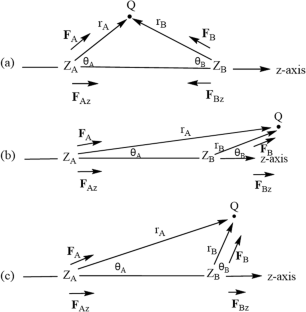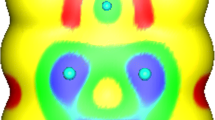Abstract
The Hellmann-Feynman theorem has, with a few exceptions, not been exploited to the degree that it merits. This is due, at least in part, to a widespread failure to recognize that its greatest value may be conceptual rather than numerical, i.e., in achieving insight into molecular properties and behavior. In this brief overview, we shall discuss three examples of significant concepts that have come out of the Hellmann-Feynman theorem: (1) The forces exerted upon the nuclei in molecules are entirely Coulombic in nature. (2) The total energies of atoms and molecules can be expressed rigorously in terms of just the electrostatic potentials at their nuclei that are produced by the electrons and other nuclei. (3) Dispersion forces are due to the attractions of nuclei to their own polarized electronic densities. To summarize, energy and force analyses should not be viewed as competitive but rather as complementary.

Similar content being viewed by others
References
Schrödinger E (1926) Quantisierung als Eigenwertproblem. (Dritte Mitteilung: Störungstheorie, mit Anwerdung auf dem Starkeffekt der Balmerlinean). Ann Phys 80:437–490
Güttinger P (1932) Das Verhalten von Atomen in magnetischen Drehfeld. Z Phys 73:169–184
Pauli W (1933) Principles of wave mechanics, Handbuch der Physik, vol 24. Springer, Berlin, p 162
Hellmann H (1933) Zur Rolle der kinetischen Elektronenenergie für die zwischenatomaren Krӓfte. Z Phys 85:180–190
Feynman RP (1939) Forces in molecules. Phys Rev 56:340–343
Hellmann H (1937) Einführung in die Quantenchemie. Deuticke, Leipzig
Coulson CA, Bell RP (1945) Kinetic energy, potential energy and force in molecule formation. Trans Faraday Soc 41:141–149
Berlin T (1951) Binding regions in diatomic molecules. J Chem Phys 19:208–213
Bader RFW, Jones GA (1961) The Hellmann-Feynman theorem and chemical binding. Can J Chem 39:1253–1265
Bader RFW, Henneker WH, Cade PE (1967) Molecular charge distributions and chemical binding. J Chem Phys 46:3341–3363
Bader RFW (1981) The nature of chemical binding. In: Deb BM (ed) The force concept in chemistry. Reinhold, New York, pp 39–136
Wilson Jr EB (1962) Four-dimensional electron density function. J Chem Phys 36:2232–2233
Musher JI (1966) Comment on some theorems of quantum chemistry. Am J Phys 34:267–268
Slater JC (1972) Hellmann-Feynman and virial theorems in the Xɑ method. J Chem Phys 57:2389–2396
Fernández Rico J, López R, Ema I, Ramírez G (2005) Chemical notions from the electron density. J Chem Theory Comput 1:1083–1095
Deb BM (1981) Preface. In: Deb BM (ed) The force concept in chemistry. Reinhold, New York, p ix
Isaacson W (2007) Einstein: His life and universe. Simon and Schuster, New York, p 549
Levine IN (2000) Quantum chemistry5th edn. Prentice Hall, Upper Saddle River
Deb BM (1973) The force concept in chemistry. Rev Mod Phys 45:22–43
Epstein ST (1974) Generalized Hellmann-Feynman theorems and hypervirial theorems for Xɑ-like methods. J Chem Phys 60:3328–3329
Gáspár R, Nagy Á (1987). Int J Quantum Chem 31:639–647
Hohenberg P, Kohn W (1964) Inhomogeneous electron gas. Phys Rev B 136:864–871
Epstein ST (1981) The Hellmann-Feynman theorem. In: Deb BM (ed) The force concept in chemistry. Van Nostrand Reinhold, New York, pp 1–38
Møller C, Plesset MS (1934) Note on an approximation treatment for many-elecron systems. Phys Rev 46:618–622
Pople JA, Seeger R (1975) Electron density in Møller-Plesset theory. J Chem Phys 62:4566
Autschbach J, Schwarz WHE (2000) Where do the forces in molecules come from? A density functional study of N2 and HCl. J Phys Chem A 104:6039–6046
Deb BM (1981) Miscellaneous applications of the Hellmann-Feynman theorem. In: Deb BM (ed) The force concept in chemistry. Reinhold, New York, pp 388–417
Kern CW, Karplus M (1964) Analysis of charge distributions: hydrogen fluoride. J Chem Phys 40:1374–1389
Hirschfelder JO, Curtiss CF, Bird RB (1954) Molecular theory of gases and liquids. Wiley, New York
Bader RFW (2006) Pauli repulsions exist only in the eye of the beholder. Chem Eur J 12:2896–2901
Scerri ER (2000) Have orbitals really been observed? J Chem Ed 77:1492–1494
Schrödinger E (1926) Quantisierung als Eigenwertproblem. (Vierte Mitteilung). Ann Phys 81:109–139
Bader RFW (2010) The density in density functional theory. J Mol Struct (THEOCHEM) 943:2–18
Fernández Rico J, López R, Ema I, Ramírez G (2002) Density and binding forces in diatomics. J Chem Phys 116:1788–1799
Hirshfeld FL, Rzotkiewicz S (1974) Electrostatic binding in the first-row AH and A2 diatomic molecules. Mol Phys 27:1319–1343
Herzberg G (1950) Molecular Spectra and Molecular Structure, vol I. Reinhold, New York
Politzer P (1965) The electrostatic forces within the carbon monoxide molecule. J Phys Chem 69:2132–2134
Parr RG, Donnelly RA, Levy M, Palke WE (1978) Electronegativity: the density functional viewpoint. J Chem Phys 68:3801–3807
Levy M, Clement SC, Tal Y (1981) Correlation energies from Hartree-Fock electrostatic potentials at nuclei and generation of electrostatic potentials from asymptotic and zero-order information. In: Politzer P, Truhlar DG (eds) Chemical applications of atomic and molecular electrostatic potentials. Plenum, New York, pp 29–50
Politzer P (1987) Atomic and molecular energy and energy difference formulae based upon electrostatic potentials at nuclei. In: March NH, Deb BM (eds) The single-particle density in physics and chemistry. Academic, San Diego, pp 59–72
Politzer P, Murray JS (2002) The fundamental nature and role of the electrostatic potential in atoms and molecules. Theor Chem Accounts 108:134–142
Cohen M (1979) On the systematic linear variation of atomic expectation values. J Phys B 12:L219–L221
Levy M, Tal Y (1980) Atomic binding energies from fundamental theorems involving the electron density, <r−1>, and the Z−1 perturbation expansion. J Chem Phys 72:3416–3417
Eisenschitz R, London F (1930) Über das Verhӓltnis der van der Waalsschen Krӓfte zu den homöopolaren Bindungskrӓften. Z Physik 60:491–527
London F (1937) The general theory of molecular forces. Trans Faraday Soc 33:8–26
Salem L, Wilson Jr EB (1962) Reliability of the Hellmann-Feynman theorem for approximate charge densities. J Chem Phys 36:3421–3427
Hirschfelder JO, Eliason MA (1967) Electrostatic Hellmann-Feynman theorem applied to the long-range interaction of two hydrogen atoms. J Chem Phys 47:1164–1169
Bader RFW, Chandra AK (1968) A view of bond formation in terms of molecular charge distributions. Can J Chem 46:953–966
Hunt KLC (1990) Dispersion dipoles and dispersion forces: proof of Feynman’s “conjecture” and generalization to interacting molecules of arbitrary symmetry. J Chem Phys 92:1180–1187
Thonhauser T, Cooper VR, Li S, Puzder A, Hyldgaard P, Langreth DC (2007) Van der Waals density functional: self-consisent potential and the nature of the van der Waals bond. Phys Rev B 76:–125112(1-11)
Clark T (2017) Halogen bonds and σ-holes. Faraday Discuss. 203:9–27
Murray JS, Zadeh DH, Lane P, Politzer P (2018) The role of “excluded” electronic charge in noncovalent interactions, Mol Phys, in press
Bonaccorsi R, Scrocco E, Tomasi J (1970) Molecular SCF calculations for the ground state of some three-membered ring molecules. J Chem Phys 52:5270–5284
Scrocco E, Tomasi J (1973) The electrostatic molecular potential as a tool for the interpretation of molecular properties. Topics Curr Chem 42:95–170
Murray JS, Sen K (eds) (1996) Molecular electrostatic potentials: concepts and applications. Elsevier, Amsterdam
Murray JS, Politzer P (2011) The electrostatic potential: an overview. WIREs Comp Mol Sci 1:153–163
Acknowledgments
It is our pleasure to join in honoring Professor Pratim K. Chattaraj, an esteemed friend and scientist.
Author information
Authors and Affiliations
Corresponding author
Additional information
This paper belongs to Topical Collection International Conference on Systems and Processes in Physics, Chemistry and Biology (ICSPPCB-2018) in honor of Professor Pratim K. Chattaraj on his sixtieth birthday
Rights and permissions
About this article
Cite this article
Politzer, P., Murray, J.S. The Hellmann-Feynman theorem: a perspective. J Mol Model 24, 266 (2018). https://doi.org/10.1007/s00894-018-3784-7
Received:
Accepted:
Published:
DOI: https://doi.org/10.1007/s00894-018-3784-7




